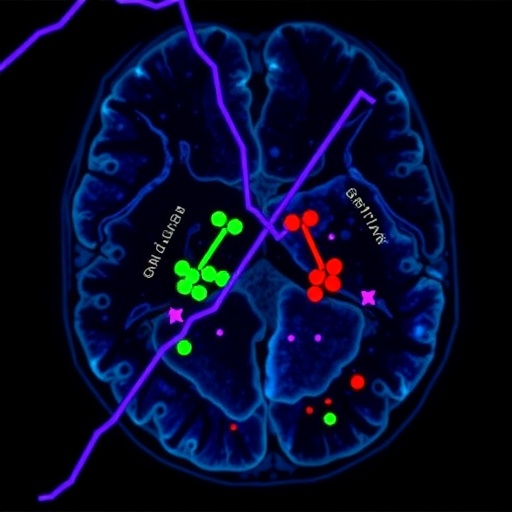
In a groundbreaking study published in the Journal of Translational Medicine, researchers have unraveled the complex relationship between the STUB1-TPIT axis and the secretion of adrenocorticotrophic hormone (ACTH) in patients suffering from Cushing’s disease. This discovery opens new avenues for understanding the molecular underpinnings of this glucocorticoid excess condition, which is predominantly characterized by the overproduction of ACTH leading to a range of severe health issues, including obesity, diabetes, hypertension, and bone disorders.
Cushing’s disease is primarily caused by pituitary adenomas that secrete excess ACTH, which subsequently stimulates the adrenal cortex to produce cortisol. The consequences of unregulated cortisol production are profound, affecting multiple organ systems and significantly deteriorating the quality of life in affected individuals. This study highlights the need for a better understanding of the regulatory mechanisms controlling ACTH secretion to develop targeted therapies for this debilitating condition.
At the core of this research is STUB1 (STIP1 homology and U-box containing protein 1), a multi-functional enzyme known to play a role in the regulation of protein degradation via the ubiquitin-proteasome system. By examining its interaction with TPIT (Tpit), a key transcription factor in pituitary cell development and function, the researchers aimed to delineate the precise molecular pathways that govern ACTH secretion.
Utilizing a combination of in vitro and in vivo experiments, Liu et al. meticulously demonstrate that STUB1 directly regulates TPIT activity. Through ubiquitination, STUB1 modifies TPIT, thereby influencing its transcriptional activity on the POMC gene—a precursor to ACTH. This intricate feedback loop indicates a critical balance between STUB1 and TPIT, essential for maintaining normal ACTH levels. Disruption of this balance could lead to the excessive ACTH seen in Cushing’s disease.
The implications of these findings are vast, as they not only provide insights into the pathophysiology of Cushing’s disease but also pave the way for potential therapeutic targets. Should STUB1 inhibition or adjustment prove beneficial in clinical settings, it could represent a novel strategy for managing hypercortisolemia. The selective modulation of STUB1 activity to influence TPIT function could offer a more targeted approach than current treatment modalities, which often involve invasive surgical techniques or systemic medical therapies.
Moreover, the researchers identified several downstream effects stemming from the STUB1-TPIT axis. Elevated ACTH levels were shown to correlate with increased cortisol secretion from the adrenal glands, highlighting the systemic impact of this regulatory mechanism. This suggests that addressing STUB1-TPIT dysfunction could correct the hypercortisolemic state and ameliorate the myriad symptoms associated with Cushing’s disease.
In addition to elucidating the STUB1-TPIT interaction, the study draws attention to the broader landscape of pituitary hormone regulation. By integrating their findings with existing knowledge on neuroendocrine signaling pathways, the authors reinforce the notion that hormone secretion is not solely dependent on one regulator but is part of a complex web of interactions among multiple proteins and signaling cascades.
One of the most compelling aspects of this research is its translational potential. With the insights gained from this study, future investigations could explore the role of STUB1 and TPIT in other hormonal disorders. This cross-pollination of ideas might unlock further biological secrets, leading to innovative treatments not just for Cushing’s disease but for other pituitary-related conditions.
Another enlightening component of this research is its contribution to the field of endocrinology, which has historically been challenged by the intricate nature of hormone regulation. The findings underscore the importance of looking beyond traditional signaling pathways to understand the interconnectedness of various regulatory proteins and their effects on hormone release.
Furthermore, the research sparks conversations around personalized medicine in the treatment of Cushing’s disease. With genetic profiling becoming increasingly prevalent, characterizing the STUB1-TPIT axis could assist in identifying patients who would benefit most from specific therapeutic interventions based on their unique molecular profiles.
As we look to the future, the study by Liu et al. serves as a clarion call to the scientific community, emphasizing that there is still much to learn about the hormonal regulatory systems that govern our physiology. Such detailed explorations into the minutiae of cellular interactions promise a horizon filled with prospective treatments and the hope of better management strategies for individuals grappling with Cushing’s disease and other endocrine disorders.
In conclusion, the discovery of the STUB1-TPIT regulatory axis marks a pivotal moment in our understanding of ACTH secretion, transforming our approach to Cushing’s disease. The study posits STOUB1 as a potentially viable target for novel therapies, emphasizing the importance of continued research in this field. As we forge ahead, we must remain committed to unraveling the complexities of endocrine signaling in order to improve patient outcomes and enhance our overall understanding of human health.
Subject of Research
Tags: adrenocorticotrophic hormone regulationcortisol production regulationCushing’s disease mechanismsglucocorticoid excess conditionshealth issues from unregulated cortisolJournal of Translational Medicine researchmolecular pathways in hormone secretionpituitary adenomas and ACTHprotein degradation in Cushing’sSTUB1-TPIT axistargeted therapies for Cushing’s diseasetranscription factors in pituitary function




